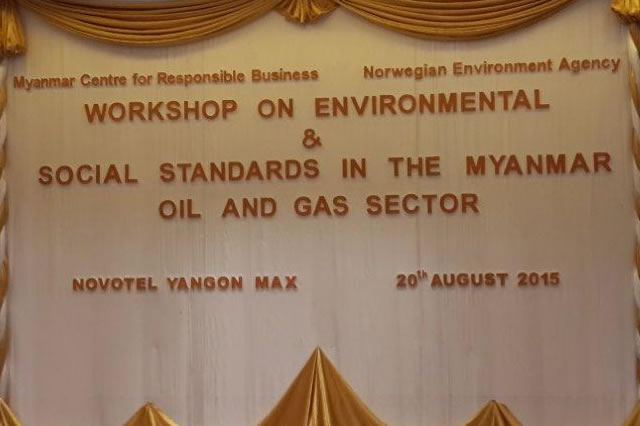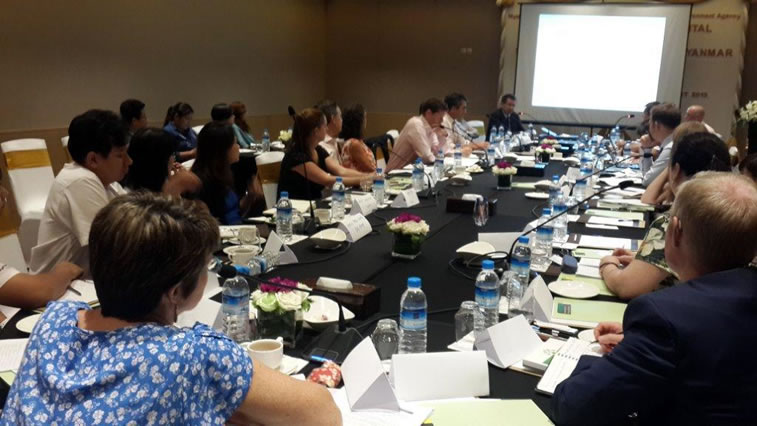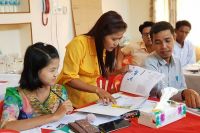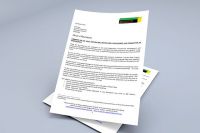Note of a Meeting on Environmental & Social Standards in the Myanmar Oil and Gas Sector

MCRB and the Norwegian Environment Agency convened a meeting with oil and gas companies on 20 August in Yangon to discuss lessons learned from the Initial Environmental Examination/Environmental Impact Assessment (IEE/EIA) process and implications for technical assistance to the Ministry of Environmental Conservation and Forests (MOECAF) and Myanmar Oil and Gas Enterprise to develop sector specific EIA guidelines for the oil and gas sector.
Around 30 participants attended drawn from 10 companies (Woodside, PTTEP, BG, Chevron, MPRL, Ophir, Shell, Berlanga, TOTAL, ENI), as well as experts from the Norwegian Environmental Agency and the consultants making up the technical assistance team (Eureka Energy, SLP Environmental and RSK).
The objectives of the meeting were to:
raise awareness of the Norwegian Environment Agency technical assistance programme on environmental and social standards, and ensure that it reflects the experience of oil and gas companies, and relevant international standards
share lessons learned from the IEE/EIA process to date, including identifying points for technical assistance or advocacy to government, as well as priorities for follow-up engagement with civil society or other organisations
obtain company input into oil and gas sector-specific EIA guidelines (for all phases of the project cycle), based on experience to date
The meeting followed on from an earlier meeting convened in August 2014 by MCRB with key government departments at national and sub-national level and oil and gas companies to discuss the IEE/EIA process prior to the commencement of companies’ undertaking IEE/EIAs for offshore 2-D and 3-D seismic.

MCRB noted that the Myanmar government has not yet finalised its EIA Procedures although a near-final draft (prepared with ADB assistance) is in circulation and companies have been encouraged by MOECAF to work on that basis (see June 2015 draft Procedures and Annex 1). The Procedures are currently with the Attorney-General’s Office, after which they will return to MOECAF with the AGO comments before submission to the MOECAF Minister and then the Cabinet for approval.
State of play of company operations
In the last 12 months, some companies have undertaken research and analysis and stakeholder consultation and completed IEEs (which MOECAF clarified was the appropriate assessment for offshore seismic), and have submitted them to MOGE/MOECAF. It should be noted that the formal Project Proponent is MOGE, and not the foreign company who is the Contractor. This is made clear in the MIC Permit.
Some companies are in the process of finalizing IEEs. One company had submitted an IEE 10 days after PSC signing, to meet the 2014/5 weather window. MOGE had obtained an approval document from the MIC. They had completed the first season of shooting seismic and would submit an end of survey report to MOGE.
Companies who have submitted IEEs in the last few months have received only limited feedback from MOECAF and MOGE. This is of concern as they want to complete seismic surveys during the weather window (November 2015 to April-May 2016). Commencement of operations (and the lead-in for procurement) requires the appropriate permits and clearances to be in place, although currently it was unclear what these were in the absence of EIA Procedures whose publication would put the system of Environmental Compliance Certificates in place.
PSCs also contain a contractual requirement to complete an EIA and SIA within 6 months of signing (which for most companies is now imminent or past). This was believed to have been included by MOGE without reference to MOECAF’s procedures. Six months for an EIA is an unrealistic timeframe (particularly in the current circumstances). There is however scope for this to be extended by MOGE[1].
The PSC wording might also be taken to read that once the first IEE/EIA is approved, it covers all future operations. However the dialogue with MOECAF has clarified from both a MOECAF and company perspective that IEE should be conducted for offshore/onshore seismic, and an EIA should be conducted for subsequent phases, and this is reflected in the Annex to the June 2015 Draft Procedures.
Norwegian Environment Agency programmme
The NEA team introduced the overall TA programme which was a precursor to an Oil for Development Programme (OfD) which the Myanmar government had requested in 2012. OfD aims to assist around 12 developing countries at any time with holistic and sustainable development of their hydrocarbon resources, based on four pillars (resources, revenues, environment and safety) in a 3-5 year programme. A programme for Myanmar is intended to start in 2016.
Eureka Energy introduced the technical assistance (TA) team (SLP and RSK) who would work with MOECAF and MOGE to establish concise Oil and Gas EIA guidelines to be submitted to MOECAF for approval in January 2016. These were intended to assist both companies and MOECAF in the production of IEEs/EIAs to international standards. The TA team’s initial analysis of the draft Procedures had identified 24 aspects which could be covered in sector-specific guidelines, but this analysis was subject to further discussion and a round of consultation in November (see presentation by Bjorn Kristoffersen, subsequently amended to reflect further discussion with MOECAF):
Companies made the following comments:
- There was continued lack of clarity concerning many aspects of the EIA framework and the hierarchy of draft documents comprising it. This was creating major legal uncertainty for companies. Early publication of the general EIA Procedures and a consistent set of other instructions was the top priority for companies. In particular:
- Until the EIA Procedures are in place, there was no legal requirement from MOECAF to carry out an EIA or MOECAF arrangements for issuing an Environmental Compliance Certificate. However MIC Notification 50 had created a requirement for EIAs for oil and gas.
- Another question raised was whether there could/should be instances when drilling projects could submit IEEs (e.g. if baseline and modelling had been established in a previous EIA for the same area).
- Certain elements of the Procedures (drafted with ADB) assistance were partially inconsistent with the two sets of Instructions recently issued for consultation (the Consultant Registration Scheme, and Administrative Instructions) which had been produced with assistance from JICA. For example the Admin guidelines required a lower level of disclosure (publish on website) compared to the Procedures (website, and deposit in local libraries etc).
- The draft EIA Guidelines (non-sector specific), produced with assistance from ADB’s GMS-EOC programme, had not been subject to consultation with companies or civil society; their content and status was generally unknown to companies and some of those present were unaware they existed. It was assumed that these would undergo further amendment to bring them in line with the EIA Procedures (or Orders) once these were finalised.
- There was already a lot of paper and a lot of detail, and not a lot of evidence that this was being read or acted on.
- One company doubted that there was space or need for a further set of oil and gas-specific EIA Guidelines, particularly if these created another layer of complexity and were pitched at a level which government was not able to implement. It needed to be simple and good, acceptable international, not best, practice. In some cases the infrastructure for best practice was not yet present in Myanmar.
- This was particularly the case as the legal status of ‘Guidelines’ was uncertain, and there was a tendency for regulators to treat all elements as compulsory standards rather than guidance.
- The draft EIA Procedures appeared to include environmental social and health impacts, but more clarity was needed on how these should be addressed. Companies preferred an integrated set of environmental, social and health guidelines. One company said their HQ required a human rights impact assessment so they would undertake this.
- MOECAF should not ask companies to provide information which was not needed (the long list of topics in the draft EIA Guidelines was cited as an example of excessive complexity – only the relevant information should be required).
- International standards were not a problem for companies to adopt. Specific standards for example from the IFC, were already included in most offshore PSCs signed in 2015 (although not earlier ones). However in some cases there was still a need for specific and simple guidance on which international standard(s) or guideline(s) to use, for example for Marine Mammal Observers.
- The focus should be on improving the process and capacity of government. For example, establishing uniform and consistent requirements would help both government and companies.
- There was a pressing need for a functioning website[2] which could contain all the documentation
- Several companies were finding it difficult to discover who and how to engage with in the government. Most of the companies have no idea where their submitted IEEs are at present, either physically or procedurally (i.e. MOECAF, MOGE or elsewhere). Communication channels between MOGE, MOECAF and the Myanmar Investment Commission were not effective.
In response, the TA team noted that they would liaise with ADB on the interplay between the general and sector-specific guidelines and ensure that these were realistic, pragmatic, consistent, added value, and did not repeat the general guidelines.
The TA programme also incorporated capacity-building for government which was a recognised need. The team was strongly encouraged by companies to focus on capacity-building and conduct its training of MOECAF (planned for late September) based on live examples i.e. the IEEs on MOECAF’s desk.
Local consultation
- Most companies said both MOECAF and MOGE had only emphasized the importance of local consultation and also asked about CSR spending plans; they had not raised technical issues,
- As a result, even companies with blocks far offshore had felt it necessary to find communities to consult although identifying projected affected people (PAPs) had been challenging, particularly as they did not want to create expectations. They had chosen a ‘typical’ community but the discussion had been rather theoretical in view of the lack of connection with their activities
- One company with a block close to shore had presented a stakeholder engagement plan to the Chief Minister; they had been able to have access with their local EIA consultants to all villages proposed. Materials for consultation had been translated; the consultation had included an introduction to seismic, and discussions had focussed on nearshore fishing.
- On CSR spending, one company commented that they had told MOECAF/MOGE that they first needed to understand the local context and community needs, and that it needed to be consistent with their overall social performance strategy. If they planned to support NGO partners with their own MoUs with government and approved plans, it would not be meaningful to have these activities separately approved by MOGE.
Disclosure and post-disclosure consultation
- Companies noted that although the draft procedures identified disclosure and post-disclosure consultation as a MOECAF responsibility, in practice companies were having to take it on themselves, which MOECAF had agreed to.
- One company said that they had asked MOECAF when this should be conducted, and been told it was when MOECAF received the report. However as the company was not responsible for submitting the report to MOECAF, it was hard to know when that point had been reached.
- One company had proposed a second consultation but been informed by the Chief Minister that this would not be necessary.
- Another company planned a second, pre-seismic, consultation and to appoint community liaison officers during the seismic period, particularly for fisheries liaison
Waste management
- One company said that any waste that could not be discharged to sea would need to be returned to a MARPOL approved onshore facility. Another company with existing operations said that hazardous waste was sent to MOGE’s Thaketa base. Another said that they were storing it and recycling what they could, pending the establishment of disposal facilities (it was noted that Dowa were constructing such a facility at Thilawa).
- One company noted that waste disposal standards needed to be tailored to the development phase (eg a single well) and also depth. They should be what is achievable and acceptable internationally.
Environmental Quality Guidelines and Standards
- It was noted that the general EQ Guidelines were in final draft but had not yet been approved. These had been compiled from several sources. Some companies had seen them. It was not clear whether they represented emission limit values, or limits for the receptor. There was a concern that even if they represented Guidelines, a regulator who did not under the issue will treat them as a default requirement. [NEA subsequently was informed by MOECAF that there was a target date of 2017 for adoption of EQ Standards to replace Guidelines].
Follow-up
- The TA team said that they would welcome a further meeting with companies in November.
[1] Example from Model PSC: Art 1.39 “Preparation Period” means a period of six (6) months starting from signing date of this Contract during which Environmental Impact Assessment (EIA), Social Impact Assessment (SIA) and Environmental Management Plan (EMP) shall be conducted by the CONTRACTOR in respect of the Contract Area. Art 3.2 The Preparation Period shall begin on the Effective Date and shall continue for a period of six (6) months and may be extended to a certain period by sole discretion of MOGE based on issuance of Myanmar Investment Commission’s approval on Environmental Impact Assessment (EIA), Social Impact Assessment (SIA) and Environmental Management Plan (EMP) reports.
[2] The Myanmar Environmental Information Portal http://meip.gms-eoc.org:8080/ set up by ADB for the Environmental Conservation Dept contains no information about EIA procedures or published EIAs; it has a Myanmar language version of the Environmental Conservation Rules
အထက်ပါအကြောင်းအရာနှင့်ပတ်သတ်၍ ဆက်လက်ဖတ်ရှုလိုပါက
- Rakhine State and Kyaukphyu Communities Want Companies and Government to Coordinate and Consult With Them on Community Development Programmes
- MCRB submits comments on draft Petroleum Bill
- MCRB Submits Comments to the Hluttaw on the Bill concerning Artisanal Oil Production
- Building an Effective EIA Process for Offshore Oil and Gas Operations
- ရေနံနှင့်သဘာဝဓာတ်ငွေ့
 English
English မြန်မာ
မြန်မာ မြန်မာ (unicode)
မြန်မာ (unicode)











